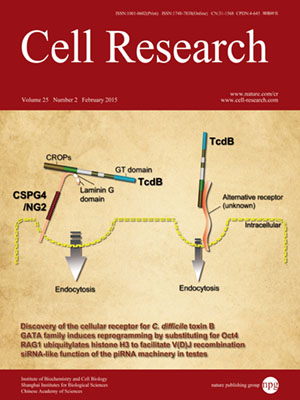
Volume 25, No 2, Feb 2015
ISSN: 1001-0602
EISSN: 1748-7838 2018
impact factor 17.848*
(Clarivate Analytics, 2019)
Volume 25 Issue 2, February 2015: 262-265
LETTERS TO THE EDITOR
Germline acquisition of Cas9/RNA-mediated gene modifications in monkeys
Yongchang Chen1,5,6,*, Yiqiang Cui2,*, Bin Shen2,3,*, Yuyu Niu1,5,6,*, Xiaoyang Zhao4, Lei Wang2, Jianying Wang2, Wei Li4, Qi Zhou4, Weizhi Ji1,5,6, Jiahao Sha2 and Xingxu Huang3,7
1Yunnan Key Laboratory of Primate Biomedical Research, Kunming, Yunnan 650500, China
2State Key Laboratory of Reproductive Medicine, Department of Histology and Embryology, Nanjing Medical University, Nanjing, Jiangsu 210029, China
3MOE Key Laboratory of Model Animal for Disease Study, Model Animal Research Center of Nanjing University, National Resource Center for Mutant Mice, Nanjing, Jiangsu 210061, China
4State Key Laboratory of Reproductive Biology, Institute of Zoology, Chinese Academy of Sciences, Beijing 100101, China
5Kunming Biomed International and National Engineering Research Center of Biomedicine and Animal Science, Kunming, Yunnan 650500, China
6Life Science and Technology, Kunming University of Science and Technology, Kunming, Yunnan 650224, China
7Shanghai Key Laboratory of Reproductive Medicine, Shanghai 200025, China
Correspondence: Xingxu Huang, E-mail: xingxuhuang@mail.nju.edu.cn; Jiahao Sha, E-mail: Shajh@njmu.edu.cn; Weizhi Ji,(wji@kbimed.com)
Precise gene targeting in monkeys will substantially facilitate generation of human disease models1,2. Although several transgenic monkey models have been successfully generated3,4,5,6, most of past endeavors in gene targeting using primates had unfortunately failed. The usage of reprogrammable endonucleases, such as ZFN (zinc-finger nuclease), TALEN (transcription activator-like effector nuclease) and CRISPR (clustered regularly interspaced short palindromic repeat)/Cas (CRISPR-associated) system, has opened new avenues for precise gene modification in monkeys1,2. Among these, the CRISPR/Cas9 system has shown to be most efficacious in gene targeting based on its successful application in a number of animal species7,8.
10.1038/cr.2014.167
FULL TEXT | PDF
Browse 2976


